Road 96 is a procedural road trip of a story, featuring some tight tunes, and a lot of mini-games. Is it a contender in the narrative-focused game scene, or is it going 96mph in the wrong direction? The Finger Guns Review:
Road 96 is a procedurally generated road trip across the fictional totalitarian state of Petria. You play as a nameless teenager who must drive, bus, walk, and generally bum rides across the state, and as you do you’ll meet an interesting group of characters, all of which have their own reasons to be on the road, between homes, or just generally not part of this broken society. Some will come along for the ride, others you’ll meet in rest-stops, caravan parks, motels, and literally on the side of the road. Everyone has a story to tell.
If you like games like Life is Strange, where there’s lots of choice and characters and interactions are king, Road 96 is going to be the right kind of game for you. Much of the time it’s chill, leaning towards a relatively passive experience, but there’s plenty of tension under the hood. And what’s really cool is that no two players are going to play it quite the same way. We’ll get into more of the types of choices later, but when you play you could randomly meet different characters to me, have more or less money, which means you bum rides more or less often. Just that variable can mean you might meet characters in a different order or not at all. Combining the procedural element with your choices and discoveries means it truly is difficult to play it the same way twice.


Right off the bat, Road 96 seems to want to hone in on a personalised experience. This simply served to trigger in me the alarm that my choices actually in-game might mean less. You’re given a brief questionnaire about your travel preferences; with family or friends, whether you’d use a map or just go where the wind takes you, how you’d react to a bad government (the data on that one could be very telling) and what you want to get out of stories. In theory, the procedural elements of the story will then rearrange themselves to fit your preferences, meaning you may see different scenes from one playthrough to another. In practice, its the difference in time of day, or order of events that changes, and not really the interactions.
Petria is a totalitarian state (probably in America although I don’t think it ever says) in the grips of a rigged election and rife with political unrest. Cops don’t enforce justice, just the will of those in power, and you are constantly asked whether you support rebellion, voting for change, or the status quo. Many just want to get out, but there’s a gigantic wall all around the state (yeah if you’re thinking someone was inspired by Trump-era America, you’re not alone) except for in one spot on the border where imports and exports come and go.
The structure casts you as a nameless teen hitch-hiking and attempting to flee the state, by crossing the border into freedom at that checkpoint. You experience a number of episodes with other characters as you go, and as you pick different transport you can afford. On my first attempt, I gobbled up the miles exceptionally fast, so much so that I only saw about 4 episodes with other characters before I made it to the border, and then crossed without much difficulty, all within about an hour. I completed the game, I thought. Wrong. Each teen that gets across, is just one chapter of the wider story about all the missing teens of Petria – everyone who, like you, is trying to leave. You start the next chapter as a new and different (read identical) nameless teenager, with the same goal, a different amount of money, and new or familiar characters to meet. Each run to the border starts from a different place, and was unconnected to other runs apart from some character story progress.


There are some wonderful heartfelt episodes in there, and some exciting ones. Characters slowly reveal their backstories and share moments with the teen avatar. You might hitch a ride, and find a young hacker in the back seat with you, start up a conversation and help them fix their radio. Or you might camp out overnight and meet the other teens also trying to cross the border. Zoe was a particular favourite, a rebellious young rich girl also on a road trip, or Alex, a kid who was great with computers well before the tech really took off. The truck driver John has some great scenes, but the one who stole the show for me was Sonja, the southern-drawling anchor for the state TV station. Her antics always seemed to need a hapless teen to help out, or just to offload her baggage on, and each time I just enjoyed having the episode wash over me.
There’s structure to the order of each character’s story. Zoe for instance seems fairly innocuous at first, but her story develops to both exciting and heartfelt crescendos. It’s not all randomised, because it would have made no sense to see the final episode of hers before the others. They clearly come in order. Also on a second playthrough, with different choices, I experienced much the same episodes and story beats as I had the first time, with nearly the same percentage rates appearing for each character’s story. It talks a lot about choice, but there’s not much in the way of consequence.
Because of the random nature of the episodes you might get on a particular chapter, I often found I had excess money on runs when I barely ever needed it, and no money whatsoever on runs where I needed it just to eat. The procedural parts work, but do they work as well as just having a bit more of a structured storyline?
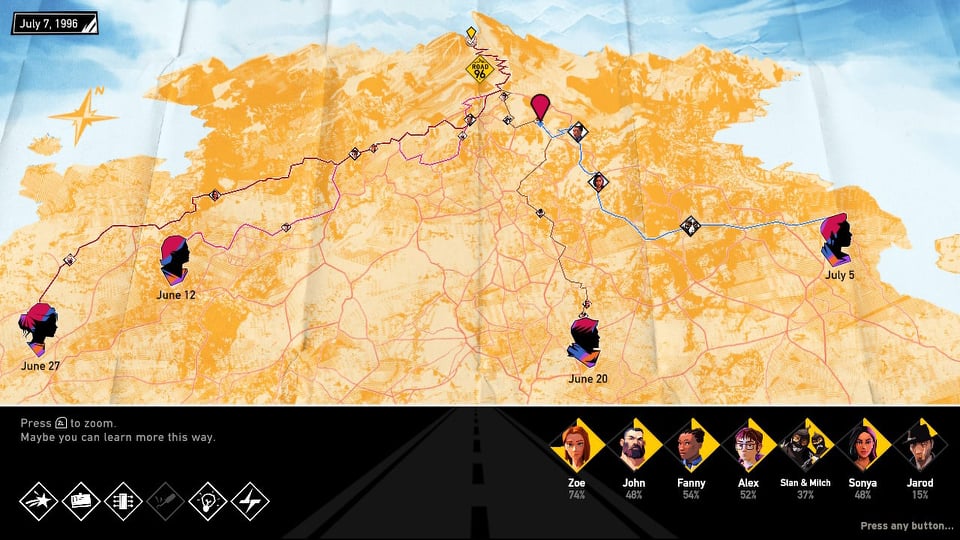

The story runs through 6 of these nameless teenagers, each sort of picking up where the others left off. Some make it to the border, some don’t. Some die with no food or energy, some make it through and smuggle themselves across in the bottom of a lorry. Each builds on the last in terms of the player’s interactions with the cast, and the wider story of Petria’s elections. My story veered into rebellion against the state, and a group called the Black Brigades who were looking to overthrow the government. Yours might have a different emphasis, but those events still happen. I don’t think it succeeds in the ambitious idea it’s marketed as, but its procedural storytelling does work. It’s generally just too simple and doesn’t allow for the kind of choice it says you can have.
I found the process of changing to a different nameless teenager each time, threw off my rhythm and left personal relationship building behind. No relationship lasted beyond one chapter. While playing I had a wild idea for a structure before the existing one revealed itself, and, thinking I was onto something, was a little disappointed when this didn’t transpire. I think with a few changes the story could have hit a lot harder.
Instead of 6 nameless teenagers, it would have worked better if you were one teenager, nameless or not. Instead of getting across the border or not, and then starting afresh, it should have been that you reached the border and failed to get across each of the first five times, caught by border patrol for example. The game often talked of The Pits, where disobedient teens disappeared too and did manual labour, yet I never saw this place. In my version, when you failed, you would then find yourself in The Pits, or a re-education camp, before finding one of a number of ways to escape and make the journey again. That way you are always you, the same character, rather than nameless avatars who come and go. Personal relationships could build up more meaningfully with the cast as they encounter this determined teen again and again, building in their notoriety. Alas, it was not meant to be.
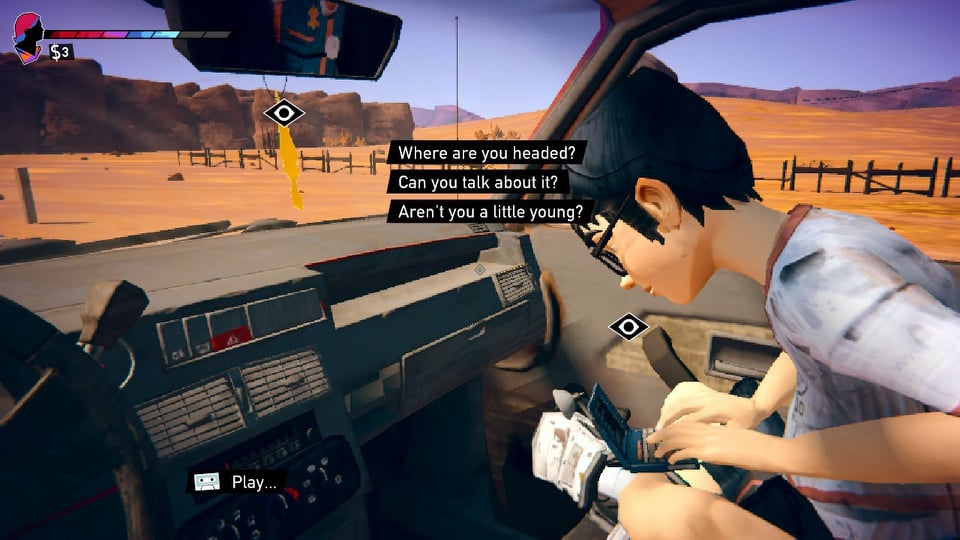

Every dialogue option in the game has at least two options, sometimes three or four. However, they are virtually always just two versions of the same sentiment. For all the seeming choice, there’s not much difference to be had. And for all its focus on choice, when walking around, most areas are very linear, not even allowing you to walk on the road or off the beaten path even one bit. You can rarely explore more than the small bounds of each episode.
Gameplay throughout each of your six runs revolves around a small survival mechanic of an energy bar that increases when you sleep or eat, and decreases when you have to walk a long way because you couldn’t afford transport, or you get yourself into a scrap in the episodes themselves, such as having to outrun the cops. Managing sleep and money may seem annoying, and based on the trailer and type of game, it wasn’t a mechanic I welcomed, nor wanted to deal with. That said it is pretty simple to manage, and it was rare that I really couldn’t find food or sleep.
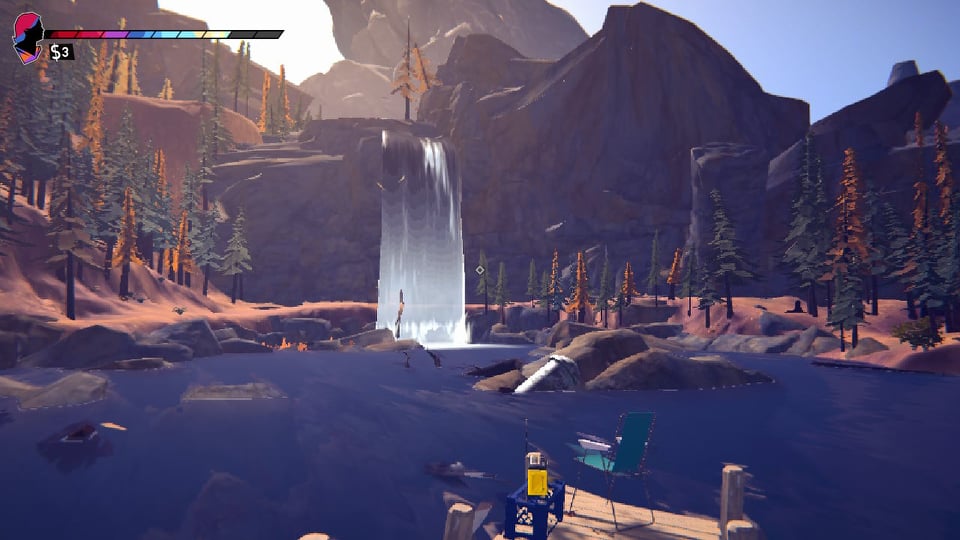

The other thing Road 96 likes to throw at you are every opportunity is a minigame. There are retro videogames dotted about the episodes, or arcade machines and such, air hockey tables to bet on etc. Even within the bounds of the episode’s stories, there are often minigame-centred mechanics, such as moving the knobs on a transistor radio to pick up a signal, pressing left and right to swerve through traffic at high speed, with cops on your tail, or answering a quiz at gun-point. These mini-games were ubiquitous in most episodes, but felt almost like deliberately gamifying sections of the story because maybe the developer wasn’t confident enough of the narrative material. Visual novels thrive with far less gameplay and don’t suffer from what I perceived as gimmicky minigames for gameplay’s sake.
Road 96 is hampered in its user interface on Switch by using a cursor. On PC, a cursor makes perfect sense, allowing ease of use via a mouse to quickly point and click. On Switch that function is left to the joycon sticks, meaning you need to navigate slowly to each option you want to click on, each dialogue choice etc. On a Switch port it would have made so much more sense to use either direct menu control (ie. Each direction up or down, or right and left bumper would navigate through choices) with an affirmation input button, or indeed touch controls. At least a handful of times I went to touch the screen to more accurately input dialogue choices, only to find nothing worked.
This came to a head in one minigame that needed movement and timing and was virtually impossible with joycon control. Thankfully it is hard to fail, but still.


Road 96 wouldn’t be described as having current-gen graphics. It’s pretty low poly overall, and has a thick-set, squared-off style that’s reminiscent of PS2-era platformers. With indie games these days, almost every graphical level is a choice. Or possibly a trade-off. With the graphics available these days, indie devs can choose to make their game in any style they want, and these guys have chosen low poly, charming but blocky characters. It’s very deliberate, and at no point did I wish the graphics were better.
The lighting throughout is lovely and atmospheric. It’s got a very chill vibe. I feel like super high-end graphics would actually not be in keeping with the world and vibe that they’ve created here, so you can see the reasons for choices made. The only issue I really had with the look of the game was that I didn’t expect the frame rate to resemble PS2 in the same way the graphics did. Things are pretty choppy out on the road.
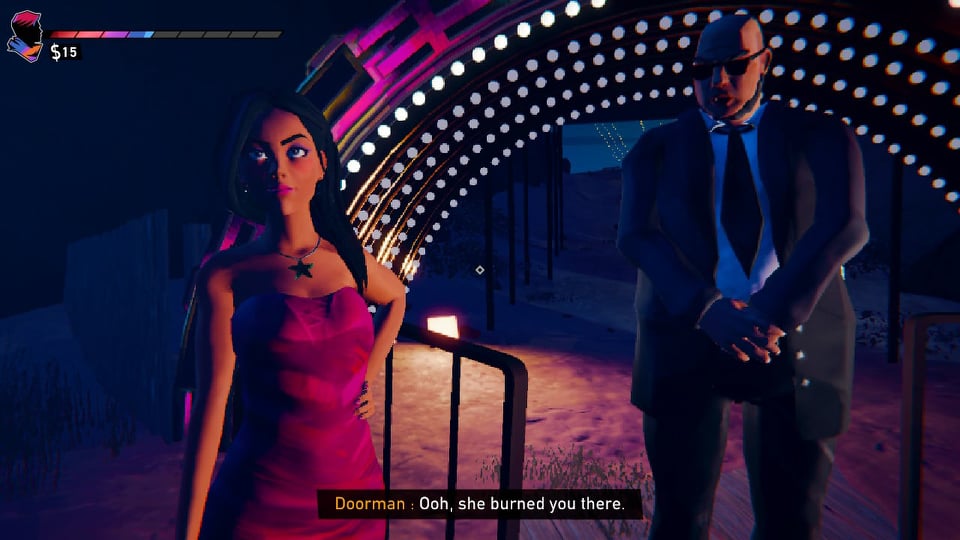

Road 96’s soundtrack is a bloody killer, especially if you are a fan of Outrun and Vaporwave, check it out here. Tracks from Kalax, The Toxic Avenger, Robert Parker, Volkor X and even SURVIVE (they did the Stranger Things theme under their real names). It’s like a gorgeous lo-fi Hotline Miami.
Set in the 90s, having a new retro and vaporwave soundtrack is like going through a fun time loop as if those songs really had existed then instead of being deliberate homages to those sounds, but it works incredibly well and again mixes with everything else to bring about Road 96’s cool vibe. It made me think of simpsonwave a few times because that so often featured cool road trip visuals.
Music is also beautifully integrated into the experience – you collect cassette tapes (that’s what came before Spotify, MP3’s and CDs for you Gen Z’s) from characters, or as rewards for searching about, and each have tracks from the soundtrack on them, just for when you have access to your own radio to play them on (just a shame it incorrectly says The Toxic Avengers on them). It’s like the Phantom Pain. It’s nice to hear these tracks, and hear characters talk about them, and gives the game world a more lived-in feel.
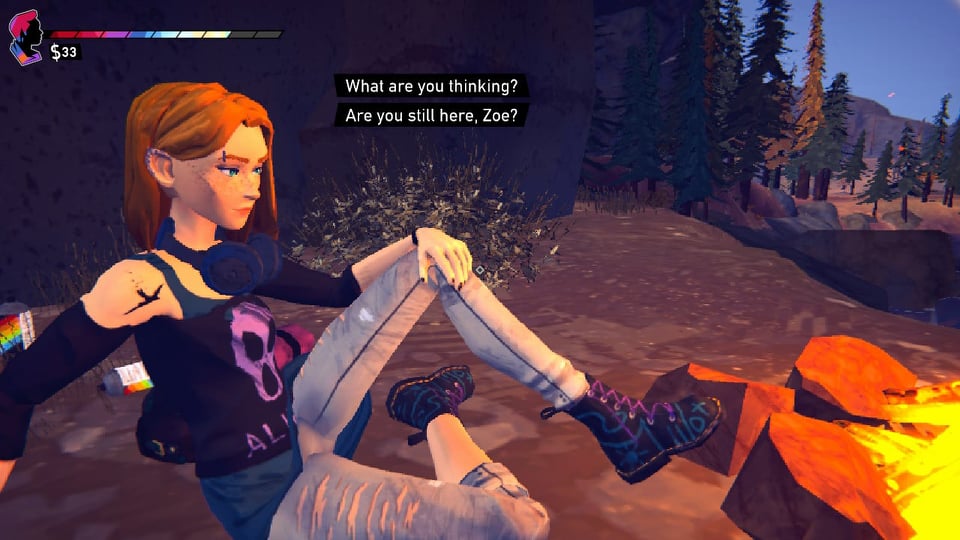

Road 96 is an atmospheric experiment in procedural storytelling that is successful more often than not. Characters and dialogue will draw you in, and the music vibe will create a soft safe place to explore for some 8 or so hours. An overreliance on minigames was to its detriment, where I think it needed to have more confidence in its characters and narrative.
The vignettes or episodes on their own work nicely, but they don’t really coalesce around a central story in a satisfying way. A handful of episodes per character will lead to a climax, but it suffered from being held together only by an impersonal nameless teenager framework that I actively didn’t like. Had the framework been a single teenager trying and failing to cross the border multiple times, I think I would have found it far more engaging.
Road 96 is an atmospheric experiment in procedural storytelling that is successful more often than not. A dynamite retrowave soundtrack and some interesting characters don’t quite excuse a story that lacks a cohesive framework and too many minigames.


Road 96 is available now on Nintendo Switch (review platform) and PC via Steam.
Developer: Digixart
Publisher: Digixart, Plug In Digital
Disclaimer: In order to complete this review, we were provided with a promotional copy of the game. For our full review policy, please go here.
If you enjoyed this article or any more of our content, please consider our Patreon.
Make sure to follow Finger Guns on our social channels –Twitter, Facebook, Twitch, Spotify or Apple Podcasts – to keep up to date on our news, reviews and features.
